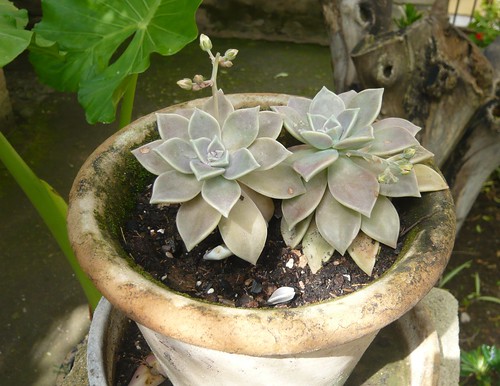Repotting Shrubs and Pot Plants
When a plants roots fill the pot then it is time to think about repotting. Compost breaks down overtime, becomes prone to waterlogging and is less aerated. Plants in John Innes No.3 compost will last a bit longer but repotting every couple of years may still be needed to retain vigour.
 Why Repot
- Repotting helps consistency of watering. You are less likely to get waterlogging or dry compacted roots that are hard to water.
- New compost and nutrient is made available to your plants.
- Cramped roots will stunt the plants ability to perform above ground.
- Tip for bulbs like Eucomis- Pot up in black plastic pots, then place inside a decorative pot in summer.
How to Repot
- Early spring is a good time to do your repotting.
- Gently ease out the root ball whilst supporting the plant.
- Tease out some compost (upto a third) from the top and bottom and free any roots that are growing round and round the pot edges.
- Lightly trim the roots from around the edges. If they are very tightly packed slice off a good sliver from one side.
- Select a slightly larger pot, place the plant in the centre at the same depth and fill in the sides with fresh compost. Push compost down to avoid air pockets.
- Add some slow release fertiliser granules as you repot and push some into the old root ball.
- In years when you do not repot, top dress the pot with fresh compost by scraping away the top 2″ and adding fresh compost.
- An over-potted plant will focus on root growth at the expense of new foliage and flowers.
- Water the repotted plant and if the compost sinks top up or add gravel as a top mulch.
Root Pruning
- Lay plants on a plastic sheet and tease out the roots removing a few inches of the compost from around the rootball.
- Avoid damage to the main root and check for pests.
- Lightly trim the fine hairy roots to restrict excess growth after repotting.
Aftercare
- After repotting drench the rootball and soil.
- Allow the soil to start drying before watering again
- Subsequently water little and often feeding regularly when the plant is in active growth.
- When new growth starts and the plant is re-established in the pot pinch back new shoots or trim as appropriate
Repotting House Plants
- The process is very similar to other repotting.
- It may be obvious that a plant needs repotting when roots grow out of the hole in the bottom of the pot.
- Water the plant before you take it out of its current pot and let it stand for a couple of hours.
- Once repotted do not feed for 6-8 weeks as the compost should provide new nutrients.
- Keep your tools and pots clean and sterile particularly for Orchids.
- Use appropriate special purpose composts for Citrus trees, bonsai, African Violets, Orchids etc.

